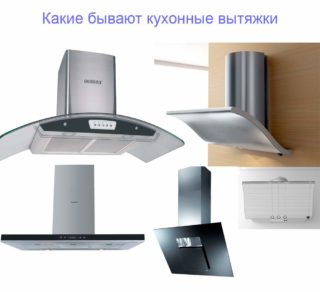It is difficult to do without a properly selected and correctly mounted hood located above a gas stove or oven in the kitchen. Its lack is especially felt by housewives who are accustomed to constantly preparing fatty fried and baked dishes, using modern hobs and powerful grills for this. With the help of a modern exhaust device, it is possible to remove foreign odors and particles and reliably protect furniture, curtains and other valuable items from contamination with fat residues. To achieve the desired result, it is important to follow the instructions in the instructions regarding the installation height of the hood above the source of harmful vapors.
Hood classification according to the principle of operation
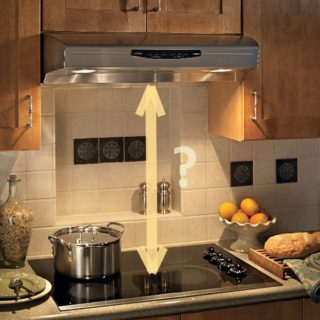
According to the principle of their action, the known models of exhaust structures are divided into the following types:
- circulation hoods equipped with special filter elements;
- exhaust devices connected to the duct (to the ventilation system in the kitchen).
In the models of the first type, the air is cleaned by means of a built-in charcoal filter and, after renewal, returns to the kitchen. Such units are suitable only for small spaces, within which the installation of the duct is difficult, and the distance from the gas stove to the hood is small.
The second option is distinguished by a greater cleaning efficiency, since the vapors in this case are completely removed to the outside through separate channels. Such samples of hoods are allowed to be installed in rooms of significant volume.
Types of exhaust devices
By design features and purpose, the products can have the following versions:
- with a flat surface;
- domed or inclined;
- desktop;
- built into a kitchen cabinet, for example.
Models with a horizontal flat surface belong to the most common type of devices and stand out among other samples for their compact size. They usually work autonomously as they have built-in replaceable filters. During the operation of such hoods, the heated air is cleared of fatty vapors in the filter element of the device, after which it enters the kitchen again.
Dome products are also in high demand among consumers. In them, the polluted air is discharged through the air duct in the kitchen directly into the street. However, in this series there are also models equipped with built-in filters. Samples of products with an inclined plane are classified as a type of typical domed devices. The height of the hoods above the hob for this option will be slightly less, due to the peculiarities of the design itself. For their manufacture, heat-resistant glass is used, which, in addition to its main purpose, performs a decorative function.
Inclined hoods are very easy to use, since their location does not interfere with the hostess of any height. Some models have the ability to adjust the middle section.
The devices built into the closet are good in that they allow you to hide the not too aesthetic-looking drainage boxes. Benchtop samples are mounted directly into self-serviced equipment (in a hob, for example).
Installation site requirements
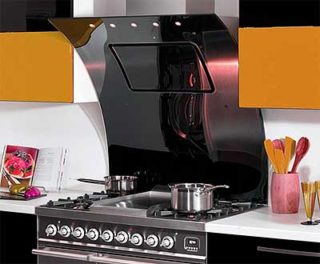
Any product is accompanied by instructions for use in everyday life, which must indicate where it can be placed and at what distance from the nearest objects it should be hung. In general, the height of the hood installation in specific conditions is stipulated. According to the instructions in this document, it is supposed to hang hoods over gas stoves at a certain level, depending on the type of heating device. When choosing a place, it should be borne in mind that this can be a product built into a wall cabinet or located directly under it. It is important that its size coincides with the dimensions of the source of pollution (hob, for example) and that it hangs exactly over it.
The distance from the stove to the body of any hood is determined by a single standard. When a typical electric stove is used in the kitchen, in the general case, the exhaust structure is located not higher and not lower than 65-75 cm from it. If the hood is hung directly above the gas stove, the distance between them will need to be increased to 75-85 cm. In a situation where the hood is mounted with an inclined surface, the installation parameters change only downward. In this case, placement restrictions look like this:
- the distance from the stoves to the hoods is reduced to 55-65 cm (meaning gas appliances);
- the hood height above the electric hob is reduced to 35-45 cm.
When choosing the exact value of this indicator, the growth of the hostess of the kitchen and the general interior of the serviced room are also taken into account.
Factors influencing the choice of location
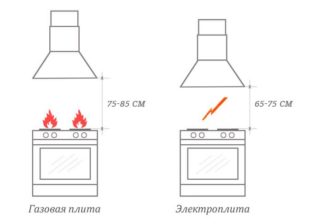
When choosing and subsequent installation of the exhaust air cleaner, the following factors must be taken into account, which directly affect the place of its installation:
- type of heat source served (electric stove or hob);
- the manufacturer's declared capacity of the exhaust device;
- interior features of a particular kitchen room.
It is also important to adhere to the requirements and regulations regarding installation within the kitchen space, which are usually given in the technical data sheet of the device. Compliance with the installation rules and the subsequent operation of the ventilation device guarantees the most effective air purification from vapors, foreign odors and the settling of fat particles on the items of the kitchen environment.
Before purchasing a specific model directly in the store, you should consult with specialists about its power. For kitchens of a large area, a device with a high indicator is suitable. In a small kitchen, it makes no sense to install a very powerful unit.
Installation rules
The efficiency of the purchased device depends on the following installation rules:
- The minimum dimensions of the purchased ventilation device are selected in such a way as to completely cover the working area of the gas stove or hob. In this case, the entire mass of contaminated hot air during operation will be completely sucked in by the hood and removed outside (filtered and fed back to the kitchen).
- The spread of standard sizes of household hoods should not go beyond the range of 60-90 cm.
The exact distance between the cooker hood and the stove depends on the type of heating unit installed in the kitchen and must comply with fire safety requirements. If necessary, information on this parameter can be found in the technical data sheet attached to the purchased device.
Installation of hoods and arrangement of air ducts
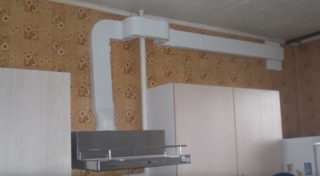
It is best to entrust the laying of outlet pipes of exhaust-type devices to professionals who specialize in arranging ventilation ducts.For users who are completely confident in their abilities, you can try to hang the device and bring the air outlet to it yourself. To do this, you will have to do a number of operations in the specified sequence:
- The height at which the structure will hang is measured, at this level several marks are made for fastenings.
- Holes are drilled in the wall for fasteners.
- The device is mounted in a marked place or on a wall cabinet by means of special hooks provided in the kit, or with self-tapping screws.
When installing hoods working in conjunction with plastic or tin air ducts, the latter are connected to the umbrella body according to the instructions. In addition to choosing a place and maintaining the required distance from the hob to the hood, SNiP prescribes to follow the rules for laying air ducts for units of the second type. In accordance with the main provisions of the standards, they look like this:
- The air duct should not have too many bends, as this can make it very difficult for the exhaust air to escape. Short and straight pipe sections with few elbows are preferred.
- The air duct route should be changed so that the resulting radius is as large as possible.
- The diameter of the outlet pipe is selected in accordance with the size of the hole already available in the hood structure. You should not specifically narrow it and install additional connecting elements between them (build up the air duct).
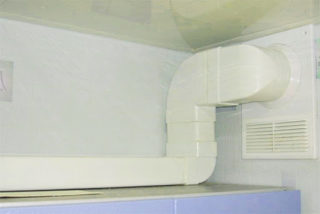
Violation of the latter requirement will lead to the deceleration of the free air flow and a significant increase in the load on the electric motor of the exhaust device. All together this will lead to increased noise of the system, which violates the comfortable conditions of stay in the kitchen. For the arrangement of a complex network of air ducts, pipes made on the basis of thick foil are usually used. From above, they are closed with boxes made of PVC or plasterboard blanks, which will give the design an aesthetic appearance and not disturb the interior of the kitchen.
After installation of ventilation equipment, it will be necessary to carry out a control check of its operability. Particular attention is paid to the control of the tightness of the hood connections with the outlet pipes and the noise level of the system. If you hear loud whistling sounds during operation, you need to carefully check the mating points and, if necessary, additionally seal them.
Electrical connection
When installing the hood, you should decide on the procedure for connecting the device to the household electrical network. For this type of equipment, it is advisable to conduct a separate supply line, protected by a circuit breaker with a rating of at least 25 Amperes. It is especially important to choose the right location for the power outlet. According to the current regulations, the electrical outlet for connecting the fume cupboard must be located at a distance of approximately 2-2.5 m from the kitchen floor. That is, it is usually located about 10-20 cm above the wall cabinets.
In the horizontal plane, the power outlet is located slightly to the side of the hood and air duct, retreating from them by about 15-20 cm.According to the requirements of the current electrical standards (PUE, in particular), electrical installation products for hoods must have a special grounding terminal. Such foresight will reliably protect the user of the ventilation equipment from electric shock.
Operating tips
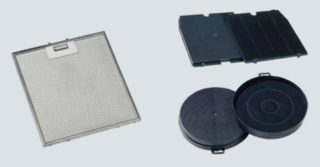
In the process of using the hood, it is important to monitor its cleanliness and good technical condition. According to the instruction manual, it is necessary:
- wipe the hood from dust and grease at the end of each working day;
- monitor the condition of the outlet ducts and check the existing joints for leaks;
- at regular intervals (at least 2 times a year), replace the filter elements installed in the device.
If a significant amount of dirt has accumulated on the body of the device, you will have to use a soft sponge or cloth with detergent applied to remove them. It is not necessary to water them abundantly with water, as well as to use chemical preparations containing abrasive particles hazardous to the body. Violation of this rule can scratch it and ruin the appearance of the device.
During cleaning, it is recommended to completely disconnect the power line of the household air cleaner. To do this, you can simply unplug the plug or turn off the circuit breaker responsible for the operation of this branch of the power supply. The outlet itself should be regularly checked for overheating of the housing and lead wires. If you notice significant heat build-up, contact your electrician to take appropriate action.
After completing work in the kitchen, it is recommended that you do not unplug the hood immediately. It is better to let it run for a while until the remnants of steam particles with fat and other vapors are removed.

